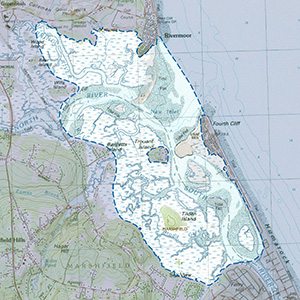Important Bird Area: North River Mouth and Corridor
Site Summary
Nominated By
David Clapp, Scott Hecker
Size
2,500 acres
Towns and Counties
Hanover, Marshfield, Norwell, Pembroke, Scituatel; Plymouth
Ownership
municipal, federal military, federal non-military, private, nongovernmental organization
Major Habitats
20% emergent freshwater wetland, 30% salt marsh, 10% coastal beach, 20% marine/tidal, 20% river/stream, migratory stopover site
Land Use
70% nature & wild-life conservation/land trust, hunting/fishing, 30% other recreation or tourism, fisheries/aquaculture, suburban/residential, military, undeveloped
IBA Criteria
- Category 1: Raptors: The site is a bottleneck or migration corridor for more than 5,000 migratory raptors during a migration season.
- Category 2: Waterfowl: The site regularly supports 500 or more waterfowl at any one time. The designation "waterfowl" includes birds such as loons, grebes, cormorants, geese, ducks, coots, and moorhens.
Site Description
This corridor extends from the mouth of the river upstream past Route 3 for 400 yards. The river runs between Marshfield and Scituate, until at the river mouth the site enters Scituate between Third Cliff and Forth Cliff. The river extends westward until it turns southerly in Hanover. The best bird habitats are at the mouth, where there are historically relevant barrier beach nesting areas for Least Terns and Piping Plovers and significant numbers of migratory shorebirds. Upriver iin an area of narrow-leafed cattail there is a very dense population of Marsh Wrens. There are also extensive areas of salt marsh that support Saltmarsh Sharp-tailed Sparrows.
Current Conservation Status
The North River is designated a Scenic River and afforded protection by statute that is represented through the North River Commission. The commissions watches over the corridor quite closely; however, there is some residential development close to the river. One sewage treatment plant (Scituate) has a history of fouling the river downstream. There are several road crossings where runoff can be tainted. The mouth of the river is heavily used by boaters and beachgoers, who disturb nesting terns and plovers and migratory shorebirds. The site is protected with rope and fence by Mass Audubon's Coastal Waterbird Program.
Ornithological Significance
The mouth of the river (Third and Fourth Cliffs) has been a nesting area for Least Terns and Piping Plovers, and a staging area for migrant shorebirds for years. Much of the data on Red Knots was collected here. There are still large concentrations of shorebirds and loafing terns. The nearby salt marsh supports large numbers of Saltmarsh Sharp-tailed Sparrows and several species of foraging waders (Snowy Egret, Great Egret, Black-crowned Night-Heron, Little Blue Heron, and Great Blue Heron). The area of narrow-leafed cattail just east of the Route 3 Bridge contained 88 singing Marsh Wrens on June 8 2001. The passage from Corn Hill Lane in Marshfield to the upper end of the tidally flooded freshwater had 155 singing wrens in total. This is an average of almost 45 singing birds per mile of river.
Other Flora or Fauna of Significance
The North River, especially the tidally influenced freshwater areas, is quite pristine as far as vegetation goes. It has all sorts of transition zones that connect the marshes (salt and fresh) with the woodlands (red maple, oak-pine, and Atlantic white cedar). It has been by The Wildlands Trust of Southeastern Massachusetts.
Data Sources
Massachusetts Tern and Plover Surveys
Breeding Bird Survey
Christmas Bird Count
D. Clapp, personal observation
Manomet Center for Conservation Sciences has data on Third Cliff




